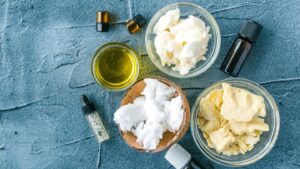Table of Contents
Understanding Emollients: Types, Benefits, and Health Tips for Radiant Skin
Emollients are an essential part of skincare routines, especially for those with dry or sensitive skin. They provide a protective barrier, enhance moisture retention, and improve skin texture, leaving it smooth and hydrated. While most people are familiar with emollients in moisturizers, the range of natural emollients and their unique benefits is broader than often realized. Let’s explore what emollients are, how they work, their types, and expert tips for optimal use.
What is an Emollient?
Emollients are substances that retain skin moisture and create a barrier that protects against irritants. Commonly found in skincare and cosmetic products, they hydrate, soften, and soothe the skin, addressing issues like dryness, itchiness, and redness. Unlike humectants that draw water into the skin, emollients work by forming a hydrophobic layer on the skin’s surface, preventing moisture loss.

What is an Emollient? Types, Benefits, and Skin Health Tip
Main Components of Emollients
- Petrolatum: Forms a strong barrier on the skin.
- Paraffin: Adds texture and smoothness.
- Glycerin: Retains water, adding softness.
- Plant-derived oils: Nourish the skin with natural fats.
The lipids in these components fill cracks in dry skin, creating a smoother appearance. Emollients aren’t standalone moisturizers; instead, they act as key ingredients within moisturizers to help lock water into the skin. [source]
Types of Emollients
Emollients come in various forms, each with unique properties. The following are popular natural emollients and their specific benefits.
Aloe Vera
Aloe vera is packed with fatty acids and antioxidants like vitamins A, C, and E. It’s widely used for its anti-inflammatory properties and ability to soothe skin irritations, burns, and even cold sores. Regular use helps maintain skin hydration and reduces signs of aging.
Shea Butter
Rich in oleic acid, shea butter is a powerhouse emollient often found in creams and balms. It softens skin, reduces wrinkles, and provides a protective layer that shields the skin from irritants, making it ideal for dry, rough patches.
Coconut Oil
Containing capric, caprylic, and lauric acids, coconut oil is both antimicrobial and deeply hydrating. It creates a barrier on the skin that helps retain moisture and reduces the signs of aging by fighting free radicals. [source]
Rosehip Oil
Rich in vitamins A, C, and E, rosehip oil is known for promoting cell turnover and protecting against environmental stressors. It’s commonly used to reduce age spots, alleviate eczema symptoms, and stimulate collagen production.
Urea Cream
Urea is part of the skin’s natural moisturizing factor, making it highly effective for treating dry and cracked skin. Synthetic urea creams smooth out rough patches and lock in moisture, making them ideal for eczema sufferers and those with sensitive skin.
Bakuchiol
As a gentler alternative to retinol, bakuchiol is a plant-based emollient that soothes the skin while reducing fine lines and wrinkles. It’s especially beneficial for people with sensitive skin who may react to harsher anti-aging ingredients.
Cocoa Butter
With a high fat content, cocoa butter is an ultra-hydrating emollient that improves skin elasticity and reduces signs of aging. Its polyphenols help smooth the skin and retain moisture, making it a popular choice for stretch mark reduction.
Squalane Oil
Derived from an antioxidant found in the skin’s sebum, squalane oil penetrates deeply to soften skin and fight signs of aging. It’s beneficial for treating acne, reducing wrinkles, and soothing eczema symptoms.
Beeswax
Beeswax offers vitamin A and has anti-inflammatory and antibacterial effects, making it great for conditions like eczema, psoriasis, and acne. It also helps protect against diaper rash and reduce the appearance of stretch marks.
Jojoba Oil
With its noncomedogenic properties, jojoba oil forms a protective layer on the skin, soothing rough patches without clogging pores. It’s also used as a natural alternative to shaving creams and scalp moisturizers, reducing dandruff and irritation.
Benefits of Emollients
Improves Dry, Cracked Skin
Emollients provide a moisturizing effect that’s particularly helpful for those with dry, flaking, and cracked skin. Studies show that emollients help break the cycle of dry skin and restore smoothness, especially beneficial for aging skin and those with eczema. [source]
Reduces Signs of Aging
By boosting hydration and strengthening the skin barrier, emollients improve skin texture and reduce wrinkles. Research highlights that fatty acids in emollients can smooth out fine lines, making them a valuable addition to anti-aging routines.
Relieves Skin Irritations
Many emollients are formulated to soothe skin irritations caused by conditions like psoriasis, eczema, and xeroderma. Their anti-inflammatory and calming properties provide relief from itchiness and redness, supporting skin healing over time.
How to Use Emollients Effectively
Emollients are versatile and come in various forms, including creams, lotions, serums, and ointments. Applying them to clean, damp skin, ideally after showering, enhances their ability to lock in moisture.
For Face and Body
Apply emollients on the face and body once or twice daily to maintain hydration. Massage them gently into the skin, focusing on particularly dry areas.
For Scalp and Hair
Emollients like coconut oil and jojoba oil are effective for moisturizing the scalp and hair. Massage into the scalp, leave for 10–15 minutes, then rinse thoroughly. Some emollients can also be used as leave-in treatments for added hydration.
Risks and Side Effects
Most emollients are safe for topical use, but some people may experience mild irritation, redness, or stinging. Discontinue use if any adverse effects occur, and consult a dermatologist if irritation persists.
Conclusion
Emollients play a vital role in maintaining skin health by locking in moisture, protecting against irritants, and soothing dryness. With a variety of types available, including natural options like coconut oil and aloe vera, there’s an emollient suitable for everyone’s skincare routine. For optimal skin health, incorporate emollients that suit your skin type and address specific concerns, whether it’s aging, irritation, or dryness.